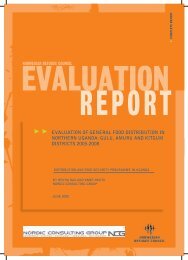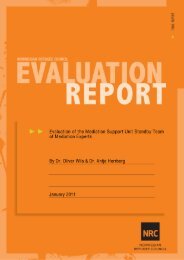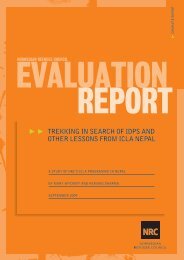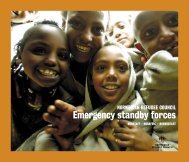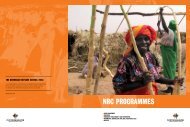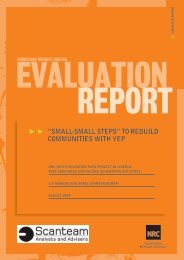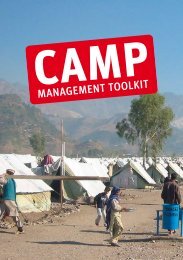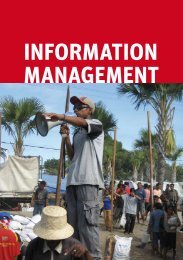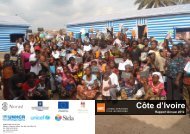Download report here - Norwegian Refugee Council
Download report here - Norwegian Refugee Council
Download report here - Norwegian Refugee Council
You also want an ePaper? Increase the reach of your titles
YUMPU automatically turns print PDFs into web optimized ePapers that Google loves.
Evaluation of NRC Food Security and Livelihoods Projects in Chiredzi and Chipinge Districts of ZimbabweGoatsSourcing goats from distant areas and other agro-ecological zones caused adverse health effects andsome either died due to failure to adapt, or reproduced more slowly. Late sourcing of goats, andcompetition from other NGOs, led to a lack of adequate discrimination in selecting goats for purchase,and in Chiredzi more bucks than does were supplied, with beneficiaries then having to try to ‘swap’these locally. If goat distribution projects are implemented in future consideration should be given toadopting a voucher-based, or conditional cash grant approach. This would enable beneficiaries to selectgoats to meet their preferences and are adapted to local agro-ecological and climatic conditions.A goat production at the scale implemented (2 females, with pass on) is a long term project which isslow to show impacts on nutrition or income. Whilst a Pass-on approach increases the number ofbeneficiaries, it also considerably delays achievement of impacts. In the NRC case, the adoption of apass-on approach, and the low number of goats distributed, meant that beneficiaries interviewed werenot yet realising the benefits in terms of increased income or nutrition, and were even experiencing adecline in income and / or other assets due to purchase of inputs / medicines. However they wereexperiencing increased status in the community, and significant satisfaction from the presence of goatsin their yard. Very few goats have yet been passed on, and some ‘pass-on’ recipients interviewed onlyreceived 1 goat because the other had died before being passed on. Goats also died during transportfor initial distribution, due to overcrowding / poor transport conditions.A greater number of goats wouldrequire to be distributed to achieve meaningful income or nutrition gains for beneficiaries in less than aperiod of many years, particularly given the pass-on of the initial goats. The negative effect on impacts ofthe pass-on element needs to be weighed against increased beneficiary numbers in future projects.An analysis of PRP projects (Killian Mutiro, GRM, 2011 1 ) indicated that in relation to goats, increasingthe number of breeding females most viable option for creating a ‘jump’ (hysteresis)to a higher wealthgroup, and that the critical number of breeding females to achieve this was 5. Based on a cost ofbreeding females of US20 to US30 each, Mutiro t<strong>here</strong>fore identified the appropriate options for smalllivestock schemes as (a) Conditional cash transfer of US150 (5 x $30), (b) Livestock vouchers worthUS150. ActionAid in Chiredzi have been giving out groups of 5 goats in their livestock projects toachieve quicker results.ChickensProblems were experienced with 100% mortality of indigenous chickens distributed. This was due to anumber of causes. The chickens were transported with goats, arrived late at night and were notunloaded until the following day. This caused considerable stress, increasing susceptibility to disease.In addition, the chickens were vaccinated against Newcastle disease the day before distribution,although the vaccine takes 2 weeks to become effective. The birds were t<strong>here</strong>fore not protected, and intheir stressed state they were easily struck by the Newcastle disease already in the area. Numerousother birds the beneficiaries already owned also died within a day or two of the NRC birds beingdistributed. Proper advance vaccination, care in transport / mimimising stress on birds, and needfor quarantining should all be addressed in future projects.It is important to note that NRC responded well to this crisis, compensating affected beneficiaries withcash grants and/or goats, so that in spite of this occurrence, all those interviewed who had been affectedexpressed high levels of satisfaction with the NRC project.4. Low Input Gardens (LIG) / Boreholes / WASHThe LIG project has had some considerable successes in achieving both improved nutrition levels andalso marketed produce. The main problems encountered have related to the adequacy of someboreholes, due to poor output and one having to be abandoned due to salinity of the water. In otherareas, the boreholes have been very successful and are not only supplying water for the gardens but arealso providing clean water to the wider community who were having to previously travel long distancesto access water. This high demand is putting considerable pressure on some of the boreholes, and1 Killian Mutiro, 2011. Determining the Value of Cash Transfers – Experiences from PRP. Paper resented at the CaLPWorkshop on “Determining the Value of Cash Transfers, November 2011, Cresta Hotel, Harare.26




